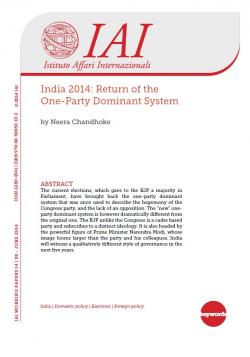India 2014: Return of the One-Party Dominant System
The current elections, which gave to the BJP a majority in Parliament, have brought back the one-party dominant system that was once used to describe the hegemony of the Congress party, and the lack of an opposition. The "new" one-party dominant system is however dramatically different from the original one. The BJP unlike the Congress is a cadre based party and subscribes to a distinct ideology. It is also headed by the powerful figure of Prime Minister Narendra Modi, whose image looms larger than the party and his colleagues. India will witness a qualitatively different style of governance in the next five years.
Paper presented at a seminar entitled "After the elections: the future of India as a regional and global power", organized by LUISS University, Istituto Affari Internazionali (IAI) and Torino World Affairs Institute (TWAI), Rome, 9 June 2014. Italian version: "India: le elezioni del 2014", in IndiaIndie, n. 2-3/2014 (luglio 2014), p. 1-4.
-
Details
Roma, Istituto affari internazionali, June 2014, 16 p. -
Issue
14|08 -
ISBN/ISSN/DOI:
978-88-98650-13-2
Introduction
1. The one party dominant system
2. What does the mandate represent?
3. The newness of the one party dominant system
4. The foreign policy angle
5. Challenges confronting the new government
Topic
Tag
Related content
-
Event13/01/2015
After the elections: the future of India as a regional and global power
leggi tutto -
Publication01/01/2015
India: le elezioni del 2014
leggi tutto



